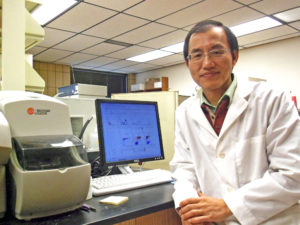Lungs may suffer when certain elements go nano
Posted by Linda Fulps
On January 27, 2014
Nanoparticles are used in all kinds of applications — electronics, medicine, cosmetics, even environmental clean-ups. More than 2,800 commercially available applications are now based on nanoparticles, and by 2017, the field is expected to bring in nearly $50 billion worldwide.
But this influx of nanotechnology is not without risks, say researchers at Missouri University of Science and Technology.
“There is an urgent need to investigate the potential impact of nanoparticles on health and the environment,” says Yue-Wern Huang, professor of biological sciences at Missouri S&T.
Huang and his colleagues have been systematically studying the effects of transition metal oxide nanoparticles on human lung cells. These nanoparticles are used extensively in optical and recording devices, water purification systems, cosmetics and skin care products, and targeted drug delivery, among other applications.
“In their typical coarse powder form, the toxicity of these substances is not dramatic,” says Huang. “But as nanoparticles with diameters of only 16-80 nanometers, the situation changes significantly.”
The researchers exposed both healthy and cancerous human lung cells to nanoparticles composed of titanium, chromium, manganese, iron, nickel, copper and zinc compounds — transition metal oxides that are on the fourth row of the periodic table. The researchers discovered that the nanoparticles’ toxicity to the cells, or cytotoxicity, increased as they moved right on the periodic table.
“About 80 percent of the cells died in the presence of nanoparticles of copper oxide and zinc oxide,” says Huang. “These nanoparticles penetrated the cells and destroyed their membranes. The toxic effects are related to the nanoparticles’ surface electrical charge and available docking sites.”
Huang says that certain nanoparticles released metal ions — called ion dissolution — which also played a significant role in cell death.
Huang is now working on new research that may help reduce nanoparticles’ toxicity and shed light on how nanoparticles interact with cells.
“We are coating toxic zinc oxide nanoparticles with non-toxic nanoparticles to see if zinc oxide’s toxicity can be reduced,” Huang says. “We hope this can mitigate toxicity without compromising zinc oxide’s intended applications. We’re also investigating whether nanoparticles inhibit cell division and influence cell cycle.”
The researchers’ findings, “Cytotoxicity in the age of nano: The role of fourth period transition metal oxide nanoparticle physicochemical properties,” were published in the Nov. 25, 2013, issue of the journal Chemico-Biological Interactions.
The research was also covered by the German news agency Wissenschaft aktuell.
Co-authors on the paper are Dr. Charles C. Chusuei, associate professor of chemistry at Middle Tennessee State University; Chi-Heng Wu, who earned a master’s degree in applied biology from Missouri S&T in 2012; Shravan Mallavarapu of Middle Tennessee State University; Dr. Fang Yao Stephen Hou, assistant professor in the clinical laboratory science department in the College of Health Sciences at Marquette University; Dr. Chen-Ming Hsu of the life science department at National Taiwan Normal University; Dr. Jeffrey G. Winiarz, associate professor of chemistry at Missouri S&T; and Dr. Robert S. Aronstam, professor and chair of biological sciences at Missouri S&T.
Share this page
Posted by Linda Fulps
On January 27, 2014. Posted in Department of Biological Sciences, Featured, Science & Tech
Leave a Reply Cancel reply
Looking for something?
Recent Posts
- Missouri S&T to host fifth annual critical minerals national workshop Aug. 6-7
- Minteer awarded NSF grant to develop sustainable fuel technology
- Missouri S&T symposium in Morocco focuses on sustainable energy for Africa
- Harrell earns biomedical research award at S&T
- Remington R. Williams Award recipient announced
Recent Comments
- Bo Mahaney on Stop repeating failure; start leading with common sense
- Dr. Raj Jayachandran on Missouri S&T Mars Rover Design Team wins University Rover Challenge
- Darnell Stokes on Exploring the future of finance: Q&A with a cryptocurrency researcher
- Larry Schnurbusch on Florida Tech leader Dr. John Harris named Missouri S&T’s new provost
- Randall Lewis on KUKA Robotics president returns to Rolla for lab dedication
Upcoming events
 Sports Headlines
Sports Headlines
- Rizq Adam Rohizam Finishes 2nd at the Singapore Open Amateur Championship
- Ethan Hudson to Serve as S&T Football Assistant Coach for Linebackers
- Connor Benjamin Secures CSC Academic All-America; Third Straight for Men’s Golf Program
- Women's Soccer Adds Four More to 2025 Class
- Golf Announces 4 Tournaments as Part of 2025-26 Season
Looking for something?
Recent Posts
- Missouri S&T to host fifth annual critical minerals national workshop Aug. 6-7
- Minteer awarded NSF grant to develop sustainable fuel technology
- Missouri S&T symposium in Morocco focuses on sustainable energy for Africa
- Harrell earns biomedical research award at S&T
- Remington R. Williams Award recipient announced
Recent Comments
- Bo Mahaney on Stop repeating failure; start leading with common sense
- Dr. Raj Jayachandran on Missouri S&T Mars Rover Design Team wins University Rover Challenge
- Darnell Stokes on Exploring the future of finance: Q&A with a cryptocurrency researcher
- Larry Schnurbusch on Florida Tech leader Dr. John Harris named Missouri S&T’s new provost
- Randall Lewis on KUKA Robotics president returns to Rolla for lab dedication
Upcoming events
 Sports Headlines
Sports Headlines
- Rizq Adam Rohizam Finishes 2nd at the Singapore Open Amateur Championship
- Ethan Hudson to Serve as S&T Football Assistant Coach for Linebackers
- Connor Benjamin Secures CSC Academic All-America; Third Straight for Men’s Golf Program
- Women's Soccer Adds Four More to 2025 Class
- Golf Announces 4 Tournaments as Part of 2025-26 Season
Missouri S&T is an equal opportunity employer
© 2025 - Curators of the University of Missouri | WordPress

2 thoughts on “Lungs may suffer when certain elements go nano”